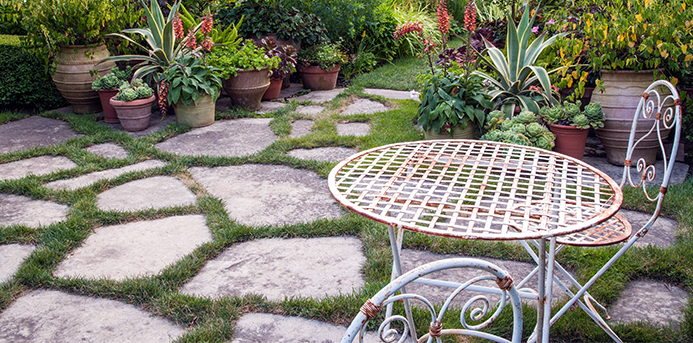It’s Monday morning and the neighbor’s landscaping crew is at it. Again. The imposing whir of mowers and blowers penetrate the air until finally, it stops. Bird song returns but clouds roll in. Just as the downpour begins, another neighbor’s sprinkler system announces its morning cycle with a sputtering shush. Water runoff gushes toward the street sewer that’s clogged with debris. Cars creep through the flood and your front yard looks like a wading pool as ripples caress what was once your grass.
This all-too-common scenario plays out in every neighborhood and it’s a far cry from sustainable.
“Environmentally sustainable” is a tag slapped on just about anything these days in an effort to make it more appealing to a growing demographic of eco-conscious consumers. However, to be truly sustainable implies that certain practices can be continued indefinitely without damaging the environment. The American Society of Landscape Architects defines a sustainable landscape as one that “…sequesters carbon, cleans the air and water and restores habitats.”
So what can you do to make your outdoor spaces more environmentally friendly? A lot. Follow these five simple practices and pass them on to neighbors. A cumulative effort makes an even bigger impact.
1. Know Your Soil
Is your soil clay, sand, loam? Not sure? Call in reinforcements. An expert will be able to tell you what nutrients are lacking with a simple soil test. Soil amendments will improve permeability, aeration and drainage. Things like composted grass clippings, leaves and well-aged manure added over a period of time are common amendments. If you’re going native, amendments may be unnecessary since local soil conditions may perfectly suit them.
Every March, the Lurie Garden receives a trim. Large mowers cut down the previous season’s growth. Instead of bagging, they leave the clippings in place to decompose and replenish the soil. This practice works in a residential setting as well. Healthy soil, happy plants.
2. Right Plant, Right Place
Where does the sun hit and for how long? Is the spot sunny in the morning and shaded in the afternoon? Answers to these questions will help with plant selection. Poorly placed plants will require more resources to keep them alive. Knowing the mature size of the plant will prevent you from having to transplant or, even worse, throw away the plant.
John Szymanski, marketing director for Mariani Landscape, has seen a shift among clients who are becoming well-versed in the value of native plants. As a result, the company has since begun incorporating natives into formal designs.
“They’re more draught tolerant, indigenous to the area and attract more beneficial insects,” says Szymanski. “They feed into the whole circle of life.”

3. Buh-Bye Chemicals
Before you reach for the Miracle-Gro, get a soil test. Your garden may not need it. The unused fertilizer will find its way into waterways, wreaking havoc on fish and other wildlife. Some native plants will actually decline from too much fertilizer. Annual flowers and vegetables, unlike herbaceous perennials, require more nitrogen and phosphorus throughout the growing season to put on a non-stop show and will benefit from regular fertilizer applications.
Instead of four lawn fertilizer applications yearly, Szymanski recommends just two using an organic product. He urges homeowners to apply it at the right time, preferably “not right before rain” when newly applied fertilizer sits at the surface and will run off into sewers.
If a plant is showing signs of decline and you suspect a pest, identify the culprit and consider all your treatment options. Selective pesticides, with labels that feature the host and the pest, are far better choices than broad-spectrum pesticides that take no prisoners. Everything dies.
Most importantly, choose plants that are disease and insect resistant.
4. Water Management
“Everyone over waters,” says Szymanski.
Irrigation systems are handy and helpful. Szymanski encourages homeowners to make sure a rain sensor is included in the system to prevent unnecessary watering. Have the system calibrated to water early in the morning to decrease evaporation.
“By maintaining your turf areas organically and using less water via irrigation, you can actually reduce the lawns need for fertilizers,” says Margaret Morrissette, owner of Architectural Gardens, a residential design/build firm in Lake Forest.
Vegetable and flower gardens need an inch of water per week. A simple rain gauge will prevent overwatering. Landscapes designed with draught tolerant plants won’t be as demanding and will need watering only until they become established.
Clear gutters of debris and place rain barrels at the downspouts to harvest water that can be used for watering plants and washing cars. Permeable pavers, used in place of concrete, for patios and driveways allow water to percolate slowly into the ground. The goal is to keep the water on your property and out of municipal retention ponds.
5. Dim the Lights
Of the billions of kilowatt hours used on exterior lighting every year, it is estimated that half go to waste. According to the Illinois Coalition of Responsible Outdoor Lighting, researchers are exploring the correlation between health issues like sleep disorders and cancers to increased nighttime lighting. Light pollution is a serious energy concern.
Solar lighting is a great option. If your home has an outdoor lighting scheme, consider equipping it with a light sensor. Unlike traditional timers that worked off the clock regardless of light availability, new sensors operate off the sun.
“There are so many little things that add up to the whole,” says Szymanski. “And there are some really tangible benefits.”

